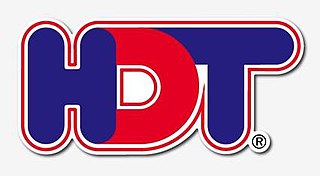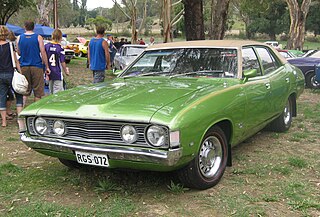| Category | Touring car racing Sports Sedan Single seaters Formula 5000 |
|---|---|
| Country | Australia |
| Inaugural season | 1970 |
| Folded | 1975 |
| Last Drivers' champion |
The Toby Lee Series was an Australian motor racing series run at Oran Park Raceway in Sydney, between 1970 and 1975.

Oran Park Raceway was a motor racing circuit at Narellan in southwestern Sydney, New South Wales, Australia which was operational from February 1962 until its closure in January 2010.
In 1970 Oran Park, with backing from sponsors Toby Lee (a brand of shirts) and department store Grace Brothers, launched a new series of races for Group E Series Production sedans. The "Toby Lee Series" usually featured a 100 lap final round and quickly became very popular, attracting large crowds to Oran Park.

Group E Series Production Touring Cars was an Australian motor racing category for production based sedans competing with limited modifications. It was current from 1964 to 1972.
The series featured a number of leading Sydney-based drivers, such as Holden Dealer Team driver Colin Bond, emerging Ford privateer John Goss, Ford stalwart Fred Gibson and Chrysler drivers Leo Geoghegan and Doug Chivas. The Toby Lee played its part in popularising production sedan racing and in establishing the passionate Holden-Ford rivalry that would endure for decades to come.

The Holden Dealer Team (HDT) was Holden's semi-official racing team from 1969 until 1986, primarily contesting Australian Touring Car events but also rallying, rallycross and sports sedans during the 1970s. From 1980 the Holden Dealer Team, by then under the ownership of Peter Brock, diversified into producing modified road-going Commodores and other Holden cars for selected dealers via HDT Special Vehicles.

Colin John Bond is a retired Australian racing driver. Bond reached the highest levels in Australian motorsport in 1969 when he was recruited by Harry Firth to the newly formed Holden Dealer Team. He quickly found success, winning the 1969 Hardie-Ferodo 500 mile race at Bathurst, New South Wales in a Holden Monaro.
Chrysler Australia, officially FCA Australia, is the importer of Chrysler, Jeep, Dodge, Alfa Romeo and Fiat vehicles for sale in the Australian marketplace. However, there had previously been a "Chrysler Australia Ltd" which had operated as a vehicle manufacturer in Australia from 1951 until 1980, and was subsequently taken over by Mitsubishi Motors Australia.
After three years of racing under Series Production regulations (1970–1972) the Toby Lee Series switched to Sports Sedans for the 1973 and 1974 seasons. 1973 saw competitive racing with big fields. Leading contenders included John Harvey and Colin Bond in Torana Repco V8s, Bill Brown and Jim McKeown driving Porsche Carreras, Leo Geoghegan's Porsche 911S, and Allan Moffat's famous Trans-Am Mustang. But when John McCormack rolled out his highly modified Ansett Charger Repco V8 in 1974 it dominated the series. This led to a lessening of interest in the series and the fields dwindled in the second half of 1974.
Jim McKeown is a retired Australian racing driver who competed in the Australian Touring Car Championship from 1964 to 1972, with a best finish of 2nd in the 1970 ATCC. McKeown was part of the successful Neptune Racing Team alongside Norm Beechey and Peter Manton. The team later became known as the Shell Racing Team and consisted of McKeown in a Porsche 911S, Beechey in a Holden Monaro GTS350 and Manton in a Morris Cooper S.
Carrera is a brand of Porsche automobile. The name commemorates the company's success in the Carrera Panamericana race.
Allan George MoffatOBE is an Australian racing driver known for his four wins in the Australian Touring Car Championship, six wins in the Sandown 500 and his four wins in the Bathurst 500/1000. Moffat was inducted into the V8 Supercars Hall of Fame in 1999.
For its final year of 1975 a radical switch was made away from sedan racing altogether and the Toby Lee became an open-wheeler Formula 5000 series. Max Stewart's Lola T400 won the 1975 series from the Matich A53 of John Goss.

Formula 5000 was an open wheel, single seater auto-racing formula that ran in different series in various regions around the world from 1968 to 1982. It was originally intended as a low-cost series aimed at open-wheel racing cars that no longer fit into any particular formula. The '5000' denomination comes from the maximum 5.0 litre engine capacity allowed in the cars, although many cars ran with smaller engines. Manufacturers included McLaren, Eagle, March, Lola, Lotus, Elfin, Matich and Chevron.

Malcolm Clarke Stewart was an Australian racing driver. He was known as the "Jolly Green Giant" for his disposition and height.
Lola Cars International Ltd. was a racing car engineering company founded in 1958 by Eric Broadley and based in Huntingdon, England. Enduring more than fifty years, it was one of the oldest and largest manufacturers of racing cars in the world. Lola Cars started by building small front-engined sports cars, and branched out into Formula Junior cars before diversifying into a wider range of sporting vehicles. Lola was acquired by Martin Birrane in 1998 after the unsuccessful MasterCard Lola attempt at Formula One.







